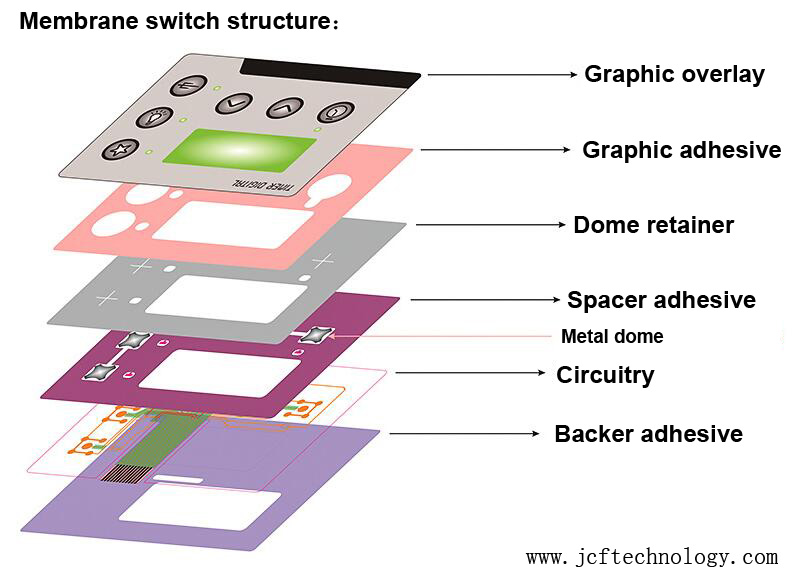Membrane Switch: Reliable, Cost-Effective, and User-Friendly Control Systems
Membrane Switch: Reliable, Cost-Effective, and User-Friendly Control Systems
Blog Article
Comprehending Membrane Layer Switches: The Secret to Trustworthy and resilient Controls

What Are Membrane Layer Switches?
Membrane buttons are a sophisticated remedy in the realm of interface technology, combining performance and style flawlessly. These tools act as an interface in between customers and digital systems, incorporating numerous elements into a portable format. Typically constructed from flexible, thin layers of products, membrane switches are designed to reply to touch, making it possible for users to communicate with equipment and electronic tools effectively.
The main elements of a membrane layer switch consist of a printed circuit layer, graphic overlay, and a spacer layer that stops unintended activation. The visuals overlay can be tailored to reflect brand identification or customer preferences, improving looks while making certain usability. Membrane switches are commonly used in various applications, consisting of clinical gadgets, customer electronics, and industrial tools, owing to their durability and resistance to ecological factors such as dampness and dirt.
One of the vital benefits of membrane buttons is their capacity to stand up to deterioration, making them ideal for high-traffic atmospheres. Furthermore, they are light-weight and need minimal room, allowing for innovative layouts in product development. Overall, membrane layer switches over stand for a useful and reliable choice for contemporary digital interfaces, marrying innovation with user-centric style concepts.
Just How Membrane Layer Changes Job
The operation of membrane switches joints on an easy yet effective mechanism that translates customer input into digital signals. When a user presses the button, the top layer warps, enabling a conductive element in the circuit layer to make contact with a matching conductive pad on the bottom of the graphic overlay.
The style of membrane switches can differ, yet they often include domes or tactile elements to give feedback to the user, improving the general experience - membrane switch. The materials utilized in membrane switches, such as polyester or polycarbonate, contribute to their longevity and resistance to environmental elements, including dampness and dirt. In addition, the published circuits are normally enveloped, which safeguards them from wear and tear over time.
Advantages of Membrane Switches

Additionally, membrane layer buttons are known for their toughness. Built from durable products, they are resistant to dust, wetness, and physical wear, which significantly extends their lifespan compared to traditional mechanical switches. This longevity makes them specifically ideal for high-traffic environments and applications needing longevity.
An additional significant benefit is the convenience of cleaning and maintenance. The smooth surface of membrane layer switches over lessens dust accumulation and is often impervious pop over here to spills, making them excellent for setups that need regular sanitization.
Furthermore, membrane switches use a structured account, leading to a thinner design that can be integrated right into different devices without including mass. This attribute not just improves the aesthetic charm yet also adds to a more ergonomic product style.
Applications of Membrane Buttons
Versatile and easy to use, membrane layer switches find applications across a wide variety of industries, consisting of medical tools, consumer electronic devices, and commercial devices. In the clinical field, these buttons are important to gadgets such as analysis devices, individual monitoring systems, and mixture pumps, where reliability and simplicity of cleaning are essential. Their ability to preserve and endure extreme atmospheres performance makes them ideal visit the website for such applications.

In customer electronic devices, membrane layer switches are utilized in items like microwaves, cleaning makers, and push-button controls - membrane switch. Their sleek layout enables user-friendly customer interfaces, boosting the overall individual experience while supplying sturdiness and resistance to tear and put on
Commercial devices likewise benefits from membrane layer buttons, particularly in control panels for equipment and automation systems. These buttons use security versus dust and dampness, making sure regular performance in tough environments. In addition, their personalized functions permit producers to customize them to specific operational requirements, enhancing performance and functionality.
Picking the Right Membrane Change
When choosing a membrane switch, it is vital to take into consideration different variables that affect efficiency and suitability page for certain applications. The main considerations include ecological problems, responsive comments, resilience, and design requirements.
First, assess the operating setting; buttons subjected to dampness, chemicals, or severe temperature levels need details materials to make sure durability and performance. Next, review the need for tactile responses. Depending upon user communication, some applications might take advantage of a responsive response to verify activation, while others may like a non-tactile style for aesthetic reasons.
Durability is an additional critical aspect; membrane layer switches must be made to endure constant use, influences, and abrasion. Ensure the selected button can endure the anticipated lifecycle, particularly in high-usage situations.

Verdict
In final thought, membrane layer switches serve as necessary components in the style of reputable and long lasting control systems across various industries. The convenience of membrane layer changes allows for customized services that satisfy particular functional requirements, strengthening their relevance in contemporary technology.
Membrane switches over represent a crucial element of contemporary user interface style, blending functionality with durability in different applications.Membrane layer switches are an advanced remedy in the realm of individual interface innovation, integrating functionality and layout flawlessly. Commonly constructed from flexible, slim layers of materials, membrane switches are created to react to touch, making it possible for customers to interact with equipment and electronic gadgets efficiently.
The design of membrane layer switches can differ, yet they frequently incorporate domes or tactile components to offer responses to the user, enhancing the total experience.In verdict, membrane switches over serve as crucial parts in the design of long lasting and dependable control systems across numerous industries.
Report this page